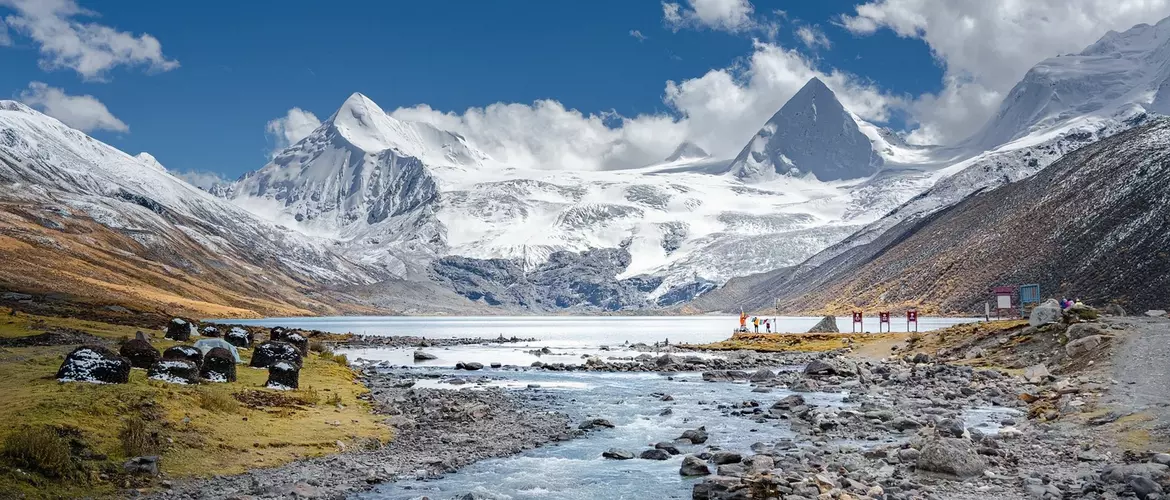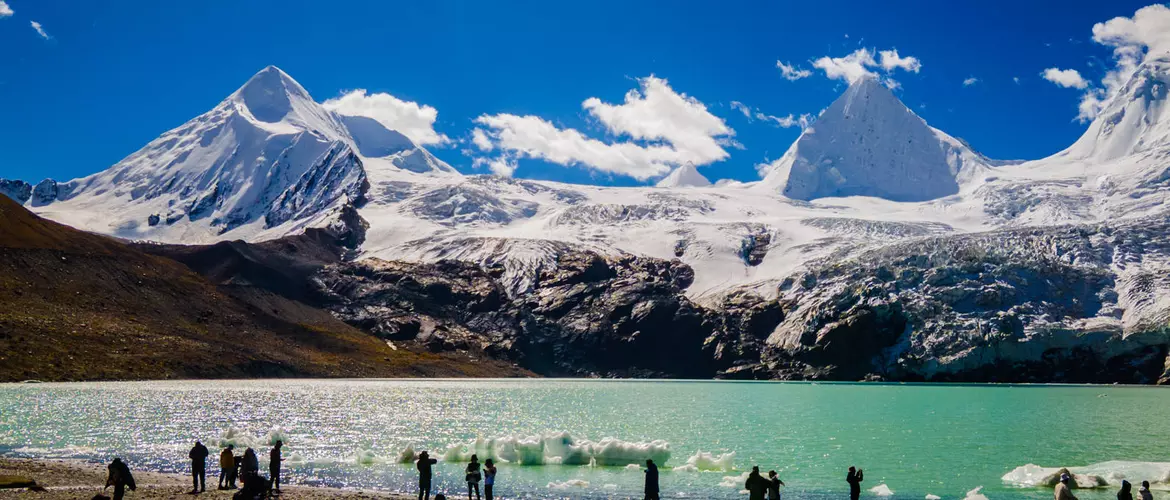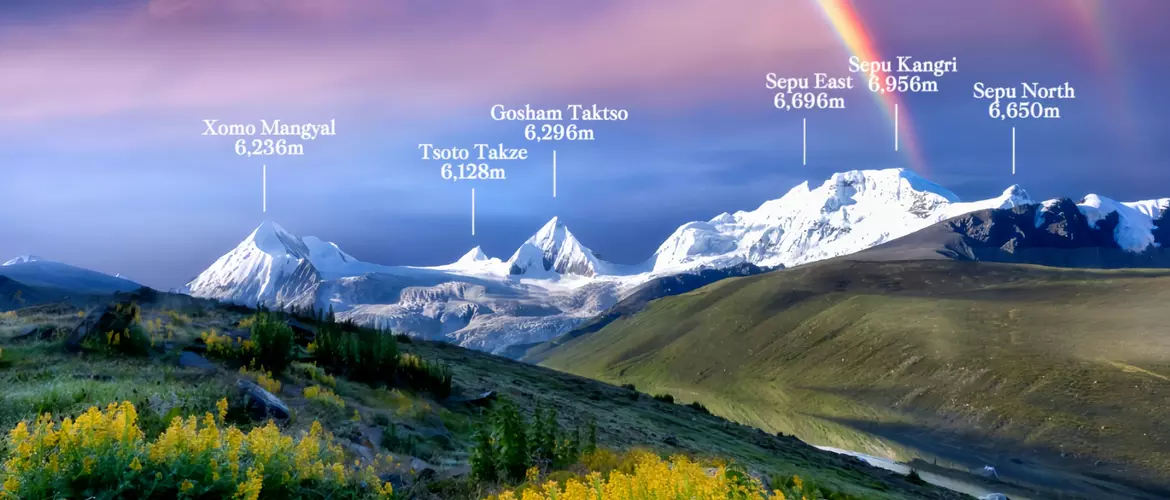Sepu Kangri
Sepu Kangri, full name Sepu Kunglha Karpo, meaning "white snow god," is revered as the king of the local sacred mountains, also one of the Bon sacred mountains in Tibetan Buddhism. The sacred mountain is located in Biru County, Nagqu Prefecture, Tibet, about 700 kilometers away from Lhasa. Surrounded by a cluster of peaks, its main peak, Sepu, at 6,956 meters above sea level, is the highest in the eastern part of the Nyenchen Tanglha Mountains.
Sepu Kangri possesses not only perfect pyramid-shaped peaks, but also shows its charm with glaciers, sacred lakes, and meadows below it. The summits of Sepu Kangri are covered in pristine snow, surrounded by clouds, while the foothills are adorned with colorful flowers and lush grass, like a fairyland. Due to the deep valleys and inconvenient transportation, this breathtaking sacred site was little known until 2017, when it gradually entered the sight of travelers.
Legend
Unlike other sacred mountains about the wars between demons and gods, the legend of Sepu Kangri is a story with strong secular colors. Sepu Kangri consists of a group of peaks, with its members arranged from left to right as follows: Sepu's wife, the illegitimate son born from Sepu's wife's affair, Sepu's second son, the eldest son, Sepu himself, and his daughter. In the legend, Sepu Kangri also took revenge on his love rival, Guobu Sacred Mountain.
What to See
Snow Mountain: The first thing that catches your eye is the diverse shapes of the snow-covered peaks of Sepu Kangri. Sepu itself, as the highest peak here, may not have a particularly unique shape. However, there are two equilateral triangular peaks, one large and one small, arranged one after the other. Their lines are flat and straight, with sharp edges and corners, as if they were measured and crafted with a ruler. Covered with snow, making them like white pyramids. At sunrise, when the golden light descends from the sky and shines on the summit of the Sepu Kangri, nature presents a spectacular golden visual feast, truly magnificent!
Sepu Glacier: People say it has the "heart" of a mountain glacier but the "appearance" of an ocean glacier, which is very special and attractive. The drop of the glacier is huge, resembling a towering wall. Standing beside the continuous Sepu Glacier, you can hear the crisp sound of ice melting, as the sun rises and the temperature increases. However, with global warming, the glacier is slowly melting.
Samu Co Lake: At the foot of the mountain, the sacred lake, Samu Co Lake, is formed by the millennia-old melting ice and snow from the Sepu mountain. It’s divided into two parts: the part near the foot of the sacred mountain is a glacial lake that remains frozen in the winter, while the other part is the main lake. According to legend, on May 15th of the Tibetan calendar each year, the lake will thaw overnight. On this day, locals host a grand and lively ceremony of circling the Samu Co Lake. Then, four months later, on September 15th, the lake water will freeze entirely overnight, very amazing!
Meadow: Following the meandering lake, there are vast meadows, solemn temples and herds of yaks, creating a rich landscape. In spring, flowers bloom profusely, and various colors cover the valleys. By midsummer, the jade-green lake reflects the blue sky, white clouds, glaciers, and snow-capped peaks, with wandering yaks along the lakeside. As autumn approaches, the golden color takes over the field of vision. In winter, you can witness blue ice comparable to the Arctic Circle, as if borrowing the colors of the sky.
Starry Sky: The starry sky of Sepu Kangri is truly worth seeing. Above the pyramid-shaped mountains, the Milky Way flows around. The majestic sacred mountain and the serene lakes also make the starry sky more vast.
How to Get to Sepu Kangri?
There is currently no public transportation directly to Sepu Kangri, so the best option is to drive there. The nearest county to the sacred mountain is Biru County. Starting from Lhasa, you can drive along G317 and Nyenchen Tanglha Mountains, via Nagqu to reach, about 700 kilometers.
From Biru County to Sepu Kangri, it's about 100 kilometers. The first 70 kilometers from Biru County to Yangxiu Township, the road is smooth and in good condition, while the latter part has a rougher road condition. After reaching the Sepu parking lot by car, you need to take a scenic bus for about 10 minutes to reach the Sepu sacred lake.
Route: Lhasa → Nagqu → Biru County→ Sepu Kangri.
Accomdation
Based on different preferences and needs, there are three different accommodation options when visiting Sepu Kangri.
1. Sepu Base Camp(4,700 meters): You can enjoy sunrise, sunset, and the night sky, but the accommodation conditions are very basic, with the potential for altitude sickness due to the high elevation.
2. Baiga Township(4,000m): Slightly better accommodation. But it needs more than a one-hour drive to Sepu Kangri, and you’ll miss out on views of sunrise, sunset, and the starry sky.
3. Biru County(4,000m): The accommodation is better, but farther from the scenic area, requiring a round trip of over 6 hours. There is limited time for visiting.
Climbing History
Chris Bonington and Charles Clarke explored the mountain in 1996. In the following two years, they tried unsuccessfully to climb Sepu Kangri. Finally, on October 2, 2002, Carlos Buhler and Mark Newcomb succeeded in their first ascent.
Travel Tips
1. The best time to visit Sepu Kangri is from May to October. During this period, the weather is relatively stable, with moderate rainfall, making it suitable for hiking and sightseeing.
2. Ticket prices: RMB50 for off-peak season (March 10th - March 31st); RMB100 for peak season(April 1st - October 31st).



